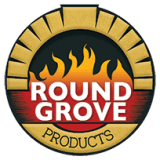A lot of customers ask about the correct height for their brick oven chimney. Round Grove Products keeps nominal height at 108” or lower in order to ship nationwide without requiring an Over Size Load permit, but most sites require a chimney extension above 108” to create the proper airflow.
I recommend walking through the site with the homeowner and educating your client about issues that influence airflow and chimney draw. The first thing I relate to clients is that every firebox will smoke until the chimney flue heats up. It is a fair expectation that exterior finishes above the firebox will exhibit some creosote build-up after the first fire. I recommend following your finishing manufacturers guidelines to address cleaning of any creosote buildup.
Next, I recommend keeping the chimney opening at least 24” taller than any other structure within a 10’ radius. That guideline has been fairly consistent since 1978 although some municipalities have more stringent building codes.
Second, I look for obstructions to air flow such as tall fences or hedges, nearby structures (especially two-story homes), and tree canopy that might require a taller chimney outlet.
The reason smoke (or other flue gas) goes up the chimney at all is because of the vacuum pressure in the chimney. Air flows away from high pressure and toward low pressure. The air pressure above the chimney should be lower than the air pressure inside the brick oven firebox. Thus, the draft effect is caused by air inside the chimney being drawn up the chimney (updraft). If the air pressure above the chimney is higher than the air pressure in the firebox, then down pressure (downdraft) will cause the smoke to exit out the front of the fireplace.
There are some design issues that encourage up pressure–getting the pressure at the top of the chimney to be lower than the firebox. The Brick Association Technical Notes 19 on Residential Fireplace Design, January 1993 is an excellent reference resource.
First, as a general rule of thumb, the flue size should be at least 10% of the firebox opening size. The bigger the firebox opening, the higher the probability for down pressure. Round Grove uses a 12” x 12″ clay flue liner that meets the criteria for fireboxes up to 48″x24″.
Second, keep the chimney and firebox openings separated as much as possible to allow area for different air pressure zones. Fire requires a great deal of air to burn, so as air rushes into the firebox to fuel the fire it should not be drawing air away from the chimney. The taller the chimney, the better the draw.
In one instance, a tall bluff behind a customer’s property created a significant downdraft that pushed smoke right back down the chimney and out the front of the firebox. We took the chimney up eight-feet above the roof, however, smoke exiting the chimney immediately flowed down to ground level even with the taller chimney. Ultimately, the customer had to install a chimney cap fan to overcome the limitations presented by their site.
So, how can designers and contractors anticipate or recognize a site’s potential for draw issues?
- keep the fireplace as far from two-story homes, fences, hedges, or tree canopy as possible
- at a minimum extend the chimney up at least 24″ above any structure that is within 10′ of the chimney opening
- consider a gas log insert as an alternative to burning wood
- consider a chimney draft inducer at the top of the chimney–a fan built into the chimney cap that requires 110-volt to operate
Consider extension size using these guidelines before ordering your fireplace. Most sites require a chimney extension to create the proper airflow. Round Grove can build any size chimney extension necessary to address most issues that influence chimney draw.
Want more brick oven tips and inspiration? Visit Brick Oven Lifestyle!
